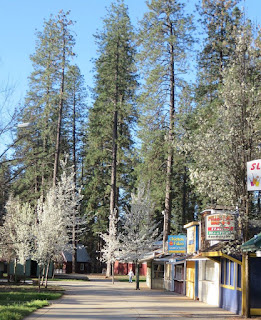Three Tips for a Killer Setting by Tracy Holczer
Every August, we take a family trip to Grass Valley, California, a smallish town in the foothills of the Sierra Nevada mountains. The mountains are dry-hot in August and so we swim in the cool, clear water of the Yuba River, jumping off white-washed rocks and body surfing the "rapids." We hike the trails if we get up early enough, and kick up orange dust which coats our socks and doesn't come out. We eat the world's best pie from the Happy Apple Kitchen. Always Dutch apple with the crunchy cinnamon top.
But the real reason we go is for the Nevada County Fair. Nestled amongst the cedars and pines, it is the kind of county fair you read about in books. Animal shows, big trucks, Clydesdales and the Northern California famous Treat Street with every imaginable carnival delicacy that exists. Homemade corn dogs, funnel cakes, baked potatoes, tempura and Carmel apples just to name a few. Sure, we ride the zipper and the giant Ferris wheel and throw things for prizes, but mostly we eat all day because everywhere you go, it smells like popcorn.
To me, setting is a beloved character. The Nevada County Fair is part of my childhood. It's existence, and my attendance, helped inform part of who I am. Setting isn't just a collection of details, it's the stitching on a quilt that holds everything together. Setting is the creation of mood, the idea that life is going on all around the story, and it gives a sense of completeness.
Three Tips for a Killer Setting:
1. Use the weather. Weather isn't just rain, snow and sun. There is fog, thunder and lightening, hail, high winds or dead calm. Think about the ways in which the weather affects not only the character's mood, but the mood of the plants and animals around her/him. Or the parents, teachers, store clerks, etc. High winds are good for sailing and kiting, bad for spreading fires or beach days. Think of everything you can do with weather.
2. Restrain yourself. Only use details of setting that are relevant to the story as it pertains to the characters' inner or external arcs, or plot. My new story is set in an apartment complex, a place where people are always coming and going, change around every corner. And one of the main obstacles the character is dealing with is her unwillingness to move on, to change. She's clinging to the past.
3. Don't ignore Writing Instincts. I had no idea about the above connection until later drafts. I think setting is one of those things that will unfold naturally if you let yourself sit back inside your character and take a look around. What do they notice? Why? Chances are this is relevant to who they are and what challenges they face.
Make every word count!
 |
| Treat Street |
 |
| Clydesdales |
 |
| The Zipper All photos courtesy of the Nevada County Fair Facebook page |
To me, setting is a beloved character. The Nevada County Fair is part of my childhood. It's existence, and my attendance, helped inform part of who I am. Setting isn't just a collection of details, it's the stitching on a quilt that holds everything together. Setting is the creation of mood, the idea that life is going on all around the story, and it gives a sense of completeness.
Three Tips for a Killer Setting:
1. Use the weather. Weather isn't just rain, snow and sun. There is fog, thunder and lightening, hail, high winds or dead calm. Think about the ways in which the weather affects not only the character's mood, but the mood of the plants and animals around her/him. Or the parents, teachers, store clerks, etc. High winds are good for sailing and kiting, bad for spreading fires or beach days. Think of everything you can do with weather.
2. Restrain yourself. Only use details of setting that are relevant to the story as it pertains to the characters' inner or external arcs, or plot. My new story is set in an apartment complex, a place where people are always coming and going, change around every corner. And one of the main obstacles the character is dealing with is her unwillingness to move on, to change. She's clinging to the past.
3. Don't ignore Writing Instincts. I had no idea about the above connection until later drafts. I think setting is one of those things that will unfold naturally if you let yourself sit back inside your character and take a look around. What do they notice? Why? Chances are this is relevant to who they are and what challenges they face.
Make every word count!
SO true about the weather. I've often used weather to mirror what a character's dealing with internally...
ReplyDelete